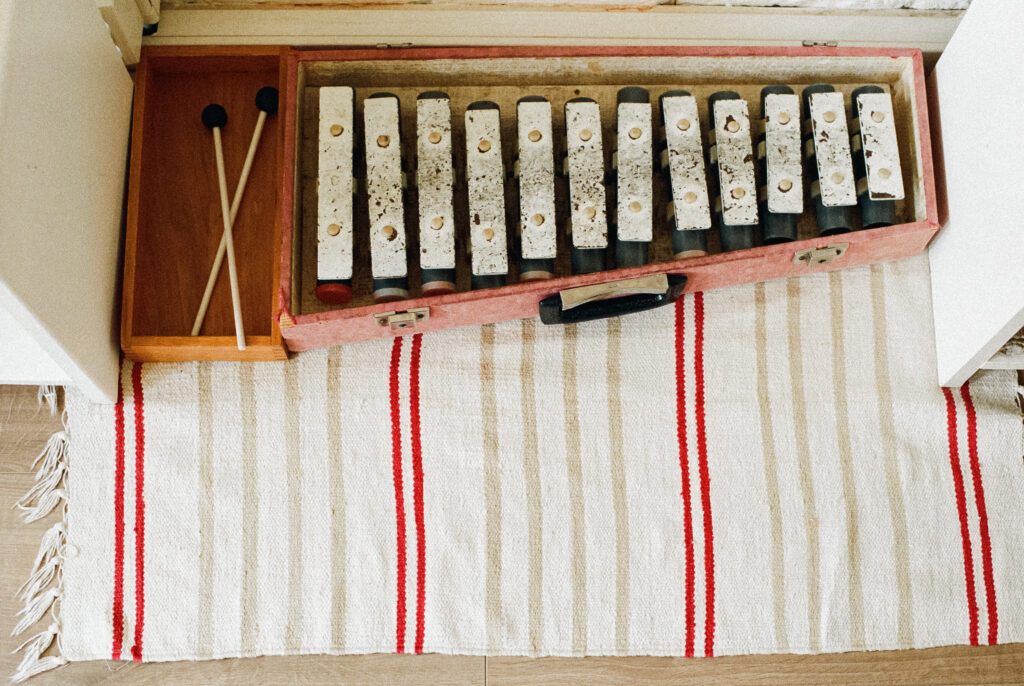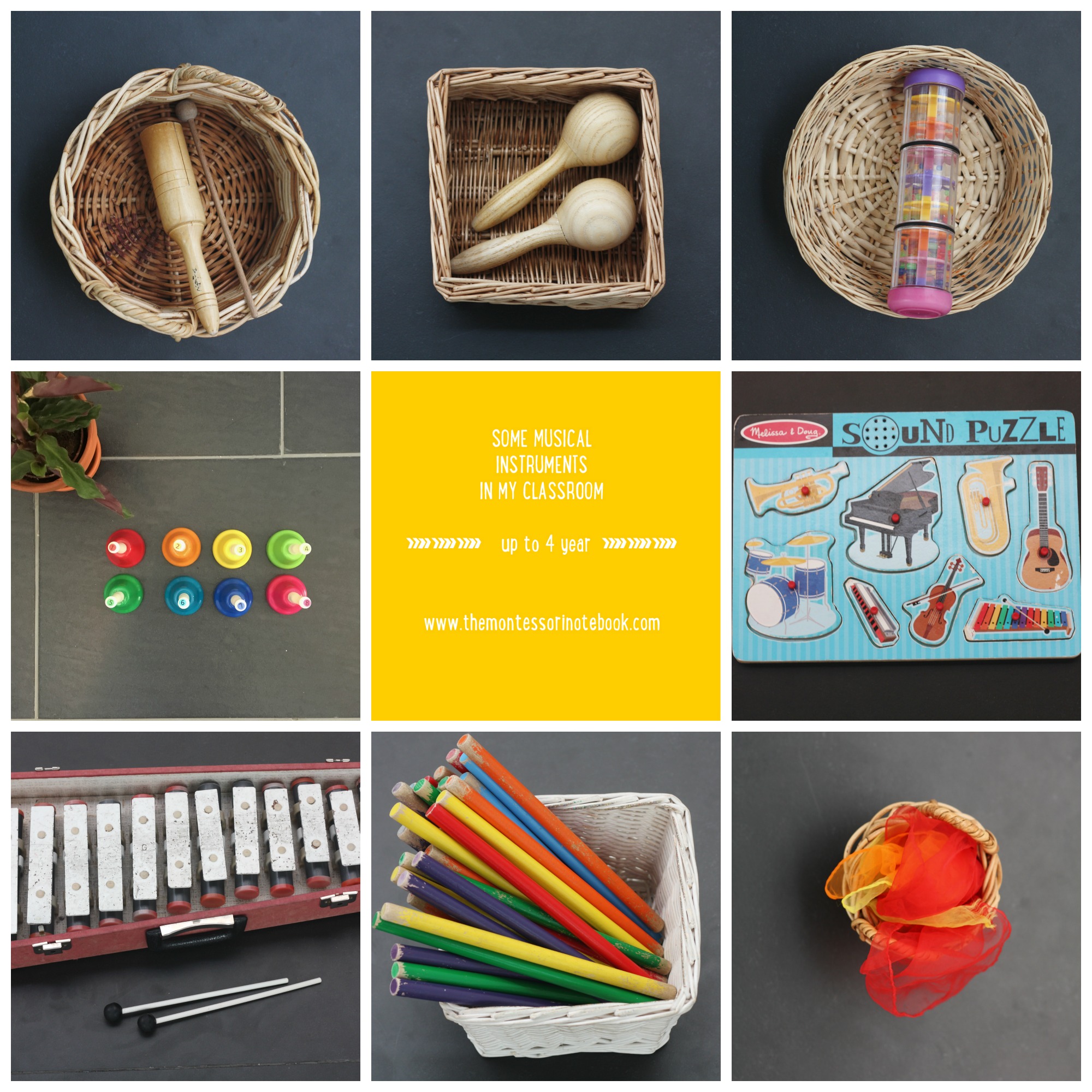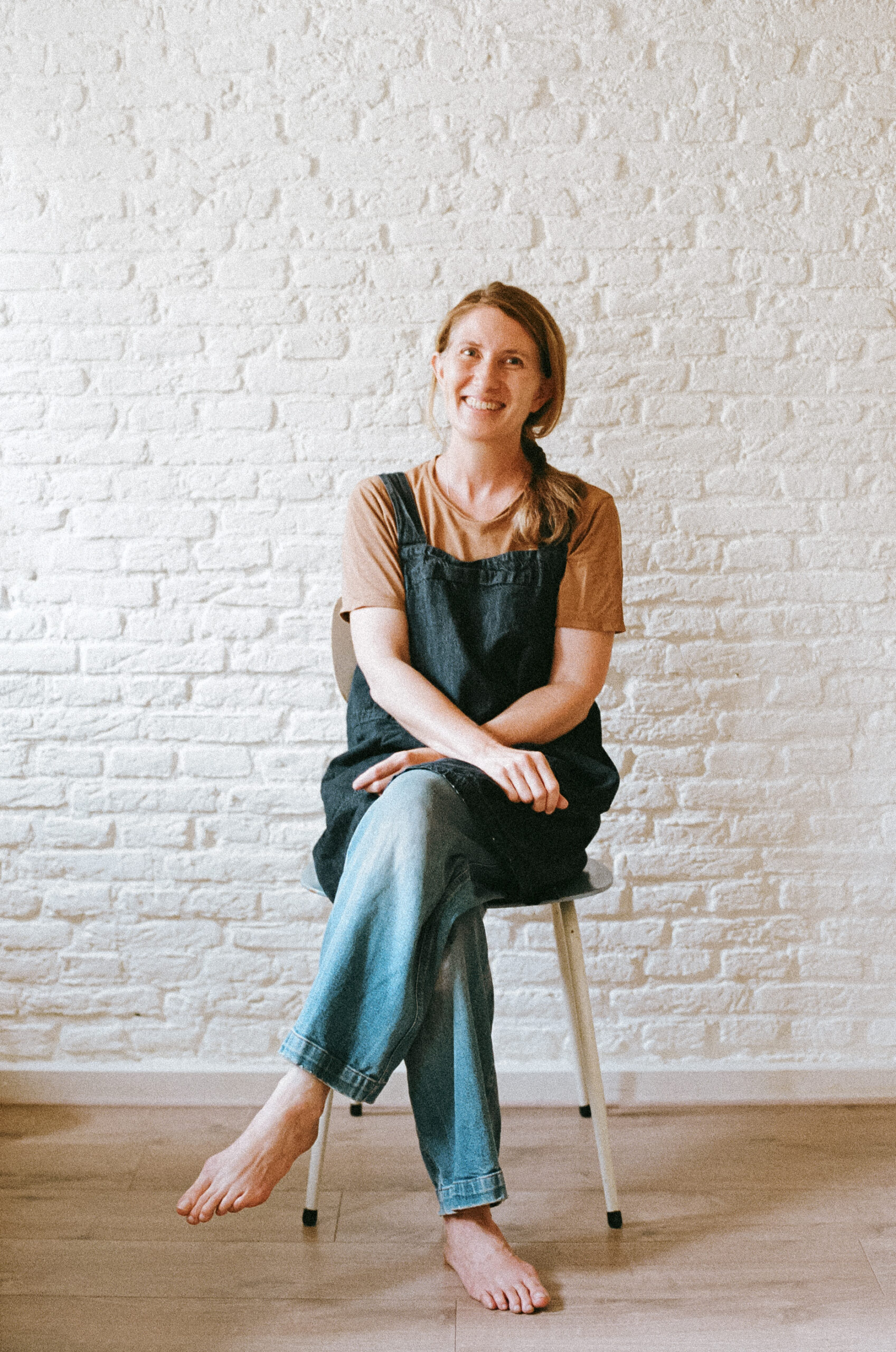Montessori and music: creative ways to integrate music in the classroom and home (including the Yoto Player!)

An often overlooked area of the Montessori classroom or home is the music area. I’ll admit, I’m not naturally musically talented. Fortunately, babies, toddlers, and preschoolers are such enthusiastic, nonjudgmental participants that I’ve never felt shy about playing music, dancing, or singing with them.
So let’s look at creative ways to incorporate music in Montessori settings. I’ve also got some beautiful images you can download to create cards while your child listens to different musical instruments.
Montessori and music
Music is so rich in terms of history, culture, and the effect it can have on our minds and body. There is almost nothing sweeter than seeing a baby starting to rock its body or move its arms when we sing together.
Music can touch us in a way that nothing else can. No better gift can we give to the children than to open this door for them.” – Dr Montessori
Music and the absorbent mind
The young child has an absorbent mind and has the ability to easily absorb and take things in from their environment. We’ve talked before about providing a rich environment for the child – a beautiful and engaging home environment, rich language spoken around them – and this includes exposure to music.
In the same way as it is important to be in a language environment to learn spoken language, we can create and provide a musical environment for children where they absorb the words of songs, the rhythms, and the appreciation for playing musical instruments.” – Judi Orion, Montessori trainer
Some examples of musical instruments in our classroom
As with other Montessori materials in the classroom, we value beauty and quality in the musical instruments we provide for children. I remember buying a wooden xylophone for my son as a baby, but its sound was disappointing—every note had the same clunky tone. Eventually, I replaced it with a high-quality metal xylophone, and the difference was remarkable; the clear, beautiful tones created a more engaging musical experience.
We are lucky to have now inherited in our classroom an instrument that is like a cross between a xylophone and chime bars (see below) – I’m informed it is a 10-tone block metallophone. The sound is just magical.

Here is a selection of musical instruments* in my classroom at Jacaranda Tree Montessori.
- Tone Block
- Maracas
- Rain stick
- Bells
- Melissa & Doug Instrument Puzzle (with sound)
- 10-tone block metallophone
- Tapping sticks
- Scarves – used for dancing, movement and 101 other things the children create

Using a Yoto player in our Montessori classroom
I bought a Mini Yoto Player to try out in our class and are having a lot of fun with it so far. I was looking for a long time for a way that the children could listen to musical instruments while looking at a picture of the instrument.
Our Yoto player set up in class
This is our current set up:
- Mini Yoto Player – keeps its charge for 14 hours; can be used with headphone; no screen (there is a small display with the track number)
- Yoto card – the player comes with one card and you can buy blank cards too. The cards can be loaded with any mp3 file. So I put some tracks on the card of musical instruments. The tracks I used are from our Montessori training. However, there is also a similar Yoto one available.
- A book with pictures of the instruments – I made this photo book myself. The book has one instrument per page with the name underneath it. There is also the track number as well. I am super happy with how it turned out.
You turn on the player and put the card in. The music starts playing. To stop the music you remove the card. Easy enough for a toddler!

What age would the Yoto player be for?
The younger toddlers are mostly turning the dials and putting the card in and out. The older toddlers around 2.5 years are listening to the music and, with some assistance, finding the instrument with the same track number. They are very engaged with it and listening to several instruments before moving on.
How many cards do you use in class? What do you suggest at home?
I want to keep it simple for the children and am planning to just use one card in class.
At home it could be lovely to have grandparents, family members, or friends to read books on them. This would be particularly useful if you don’t live nearby them or if you have a family language which is a minority language where you live.
Creating a dancing area
You could add a dancing mat to your home which could be rolled out to dance on while listening to music.
Singing time
In a Montessori classroom, we value long, uninterrupted work periods that allow children to choose their activities freely and reach deep concentration, without frequent interruptions for group activities. This freedom nurtures their focus and autonomy.
At the end of each session, we bring the class together with a short singing time. I start by gently humming, “Come and make a circle,” which signals to the children to begin packing up for our song circle. Participation is always voluntary — children are welcome to observe quietly from the side or continue their work. Even if they’re not actively singing, they’re still absorbing the music and rhythm.
I select simple action songs and sing at a slow pace, giving children plenty of time to follow along and participate fully. We repeat the same songs over a few weeks, allowing them to build confidence and mastery.
Every other week, we introduce tapping sticks. Each child receives a pair, and we explore different ways to tap along with the songs. Other instruments can also be introduced—for example, if you have 8 children, having 8 of the same instrument works best. If that’s not possible, we take turns, passing the instrument around, which creates a sense of sharing and collaboration.
FAQs – Montessori and music
How should I show my child how to play the instruments?
I find that I don’t need to give many formal presentations of the musical instruments in our classroom. The instruments I have chosen are intuitive to play, the children learn from watching the others, and I don’t want to be too prescriptive in how a child makes music.
However, it can be useful to show them how to make the sound of a guiro, rubbing the stick along the ridges, or how to hold a triangle so that it can vibrate more easily.
It can also be fun to play around with tempo (sing a song slowly, then fast), volume (sing quietly and then loudly), and rhythm (trying different patterns which the child can copy).
Sometimes I sing along as the child plays an instrument. However, my favourite moments are when I copy the child’s movements, we play the same rhythm, we stop at the same time, we start playing again together, we smile.
After all, playing music is a creative expression without rules.
Just as the child must have a desire to speak to learn spoken language1, we must foster in the child that music is a way of expressing feelings and thoughts inside us – a way of communicating – and support their musical expressions.” – Judi Orion, Montessori trainer
How should I display instruments in my home?
I’ve seen musical instruments be displayed in various ways. In our class, I have a shelf dedicated to music with a basket or tray for each instrument including any beater that may be needed. I generally have out instruments that are played in different ways, for example something you can shake, eg, maraccas; something you can strike, eg, a drum or triangle etc.
You could have a variety of instruments in a large basket or a table with a variety of musical instruments.
What kind of music should we play with our child?
Any kind of music can be played for a baby in utero and after birth to give the child a broad base of music. It may be best not to play just rock or strong, violent rhythms but include classical music, baroque classical music and the music of your culture/s.
What about playing background music?
In my Montessori training, the trainer recommended not having background music on all the time. It was recommended that it would be better to have a time for listening to music – then you and your child actively focus on the music being played, there are moments of silence and quiet during the day, and the child’s brain does not need to filter it away if they are concentrating on something else.
I’m not dogmatic about these things so if you like having music on from time to time as background, please continue to do so. Perhaps you may choose to take some breaks now and then.
When should we start playing music with our child?
It is never too early to start with music (and also never too late if you’ve not started yet). It is now well-known the effects of playing music to a baby in utero.
Amongst other benefits, in Montessori we talk about points of reference once the baby is born. Music played in utero can be one of these points of reference as a new baby comes to orient themselves in the “outside” world. The baby in utero can also have an auditory and physical memory of a state of relaxation inside their mother, if their mother relaxes when playing, listening to or singing music.
Download the images to make your own book of musical instruments
Here is everything you need to create your own photo book:
- PDF of musical instruments
- Print-friendly version of PDF of musical instruments (with white background)
- PDF of musical instruments (with numbers)
- zip file of images of musical instruments
All this talk about music makes me want to get up and dance! I hope you have a joyful time making music, singing, and dancing with your child. Embrace these moments of musical exploration—they’re not only fun but also a wonderful way to bond and support your child’s growth in a Montessori-inspired way. Enjoy every beat, every song, and every shared smile!
* if you use any links in this post, a small amount of the proceeds goes to buy materials for our class at Jacaranda Tree Montessori at no cost to you

Simone Davies has more than 20 years’ experience as an AMI Montessori educator. Simone is the author of “The Montessori Toddler” and co-author of “The Montessori Baby” and “The Montessori Child” books, comprehensive guides to raising children in a Montessori way. She currently runs parent-child Montessori classes in Amsterdam at her school Jacaranda Tree Montessori. She also has a popular blog, instagram and podcast “The Montessori Notebook” and is mother to two young adults.